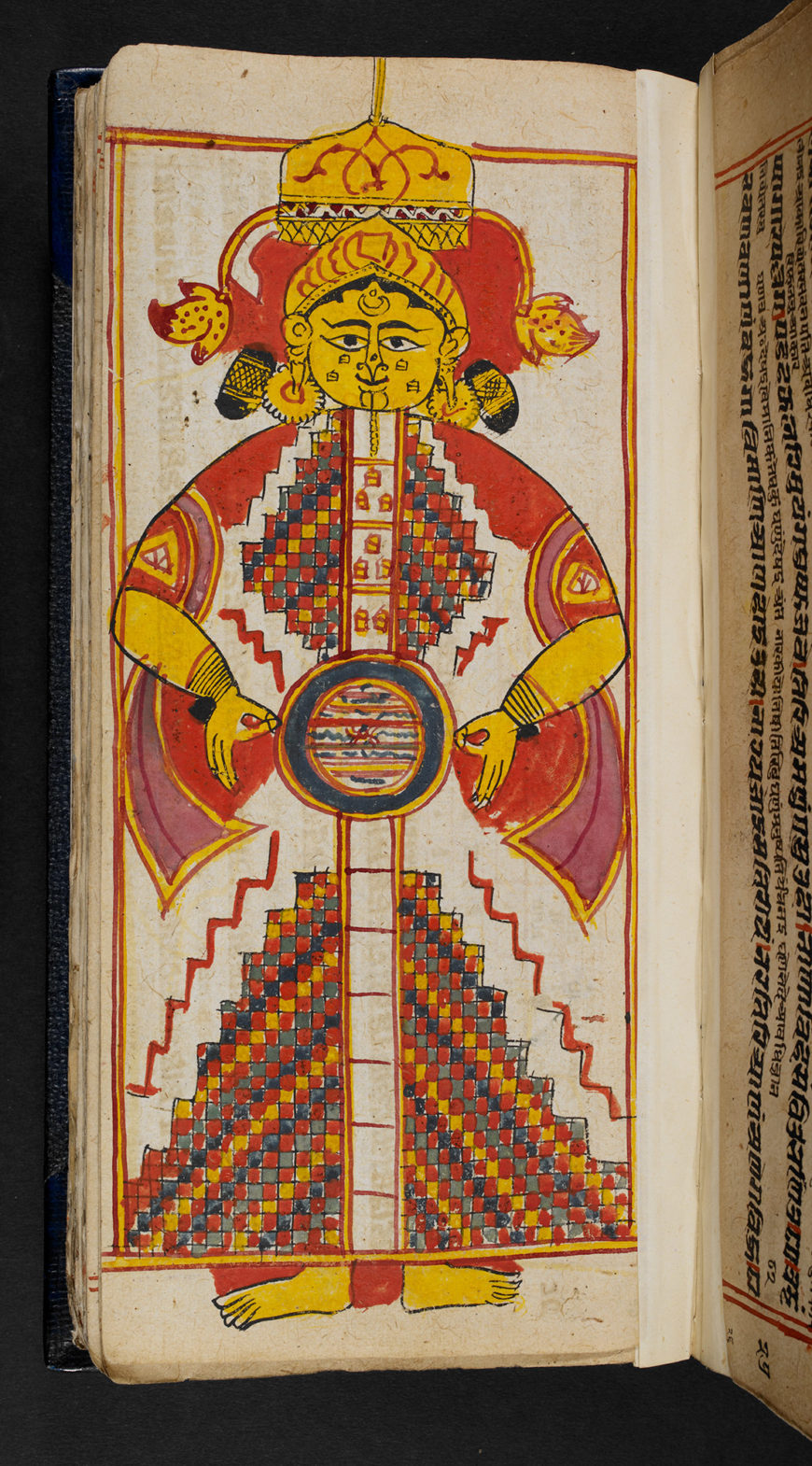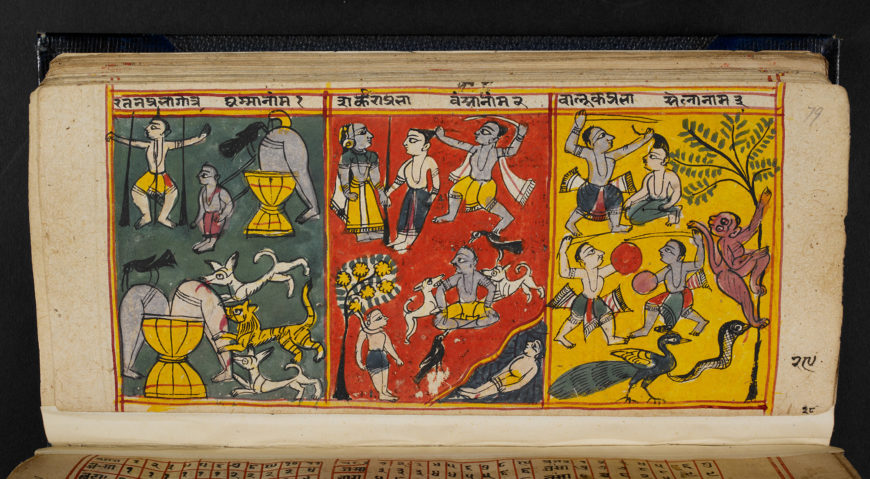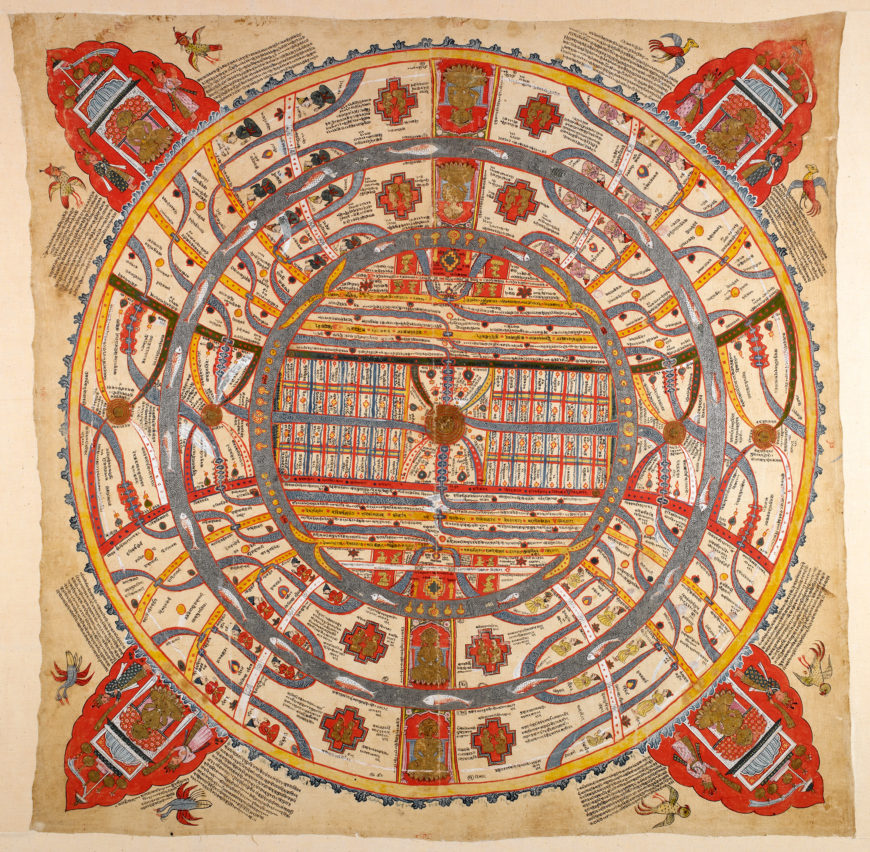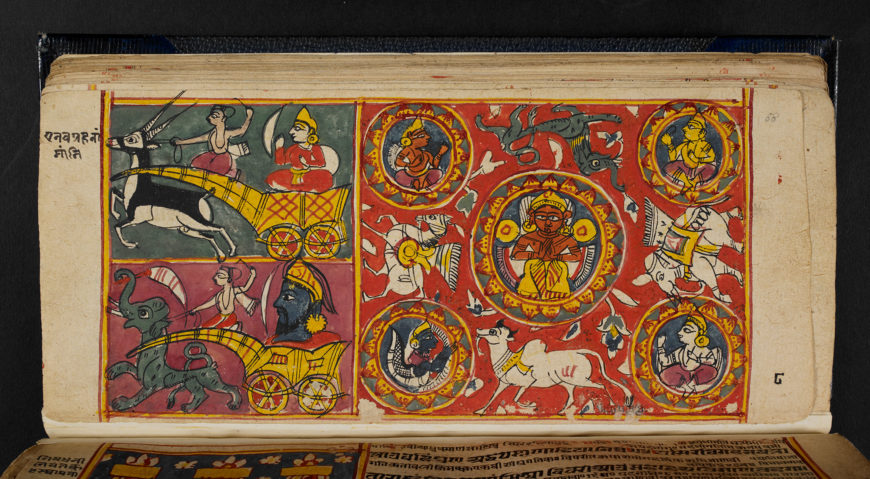What is the Jain view of cosmology?
The universe for Jains is an elaborate system. Jain cosmology is very distinctive, although it shares some features with other Indian religious traditions. It is centred on the everlasting and non-originating nature of the universe, and thus excludes the notion of a creator-god. As written by a leading monastic figure from the 12th century, ‘the universe having the shape of a man standing with arms akimbo, with feet apart, filled with substances continuously being created, preserved and destroyed, has never been produced by anyone and is not sustained by anyone either. It exists by itself, without any support’.[1] Although Jains do not worship a creator-god, deities do exist, as mediators between the perfected souls of the Jinas and the imperfect world of human experience, and are a part of the Jain cosmology.
What is the structure of the Jain universe?
The Jains distinguish two types of space. The first is the world space (loka-ākāśa), which is a vast but limited area where all souls live in the different body-forms they take according to their rebirths in the various worlds. The second is the non-world space (aloka-ākāśa), which is endless. The Jain universe is perfectly structured and ordered. One of its governing principles is symmetry and repetition, so that ‘to know one part is to know the whole’. It can be viewed as ‘a self-replicating composite’ with, for example, a northern region the exact replica of its southern counterpart, halves being identical, etc. The Jain universe is thought of in terms of dimensions and quantities of units. Jain thinkers have produced a vast vocabulary to describe and understand units of time and space, going from the smallest to the largest, beyond what can be imagined. The smallest unit is the atom. Infinite combinations of atoms make up the smallest unit of measurement. At the other extreme, Jains have devised a refined analysis of extremely large numbers, considering the numerable, the innumerable and the infinite. Jain cosmology gives an important place to mathematical concepts and calculations, so that mathematical treatises written by the Jains may take their illustrative examples from cosmological contexts. Śvetāmbaras and Digambaras agree on the structure of the universe and its elements but differ on many names and numbers.
Grasping Jain cosmology is vital to understanding the Jain religion. The soul is an innately pure substance. But, due to embodiment and activity, good or bad, it accumulates karma, which in the Jain understanding means physical matter. This alters the purity of the soul and generates cycles of rebirths within the universe until this finally ends. Rebirth can take one of the following four forms of destiny (gati): 1. as a human (manuṣya); 2. as an inhabitant of the hells (naraka); 3. as a deity (deva); or 4. as an animal or plant (tiryag). Spiritual progression requires an understanding of these cosmological theories. Contemplating the universe is also included within the system of reflection-topics (anuprekṣā).
Where do these forms live?
The world space (loka-ākāśa), where all souls live, is divided into three worlds. Their denominations of lower, middle and upper, imply the vertical representation as a cosmic man which has become familiar since at least the 17th century.
The lower world is made up of his bottom half, the middle world of his waist and the upper world of his torso. There is also an area at the top of the worlds where the liberated souls (no longer to be reborn) stay in never-ending bliss and are possessed with perfect knowledge. This is known as siddhaśilā and is represented by a crescent moon on the cosmic man’s forehead.
1) The lower world (adho-loka) is formed of a pyramid of seven superimposed hells. They are darker and darker as one goes lower. This is where the inhabitants of the hells (narakas) reside. The lower they live, the more they suffer from various tortures. Artists love to create vivid pictures of life there and the wide range of tortures hellish beings go through.
Souls are born in the hells because they have behaved violently and been extremely possessive. Such attitudes and actions break fundamental rules governing Jain life. If the hellish beings do not behave well enough to build up enough good karma to be reborn into a higher world, they are reborn next in a lower hell.
2) The middle world (called madhya-loka) is the only place where human beings (manuṣyas) live. Jains underline the difficulty of gaining birth as a human being. It is a rare opportunity because it offers possibilities for spiritual progress. The primary principle of repetition in the Jain conception of the universe is very clear in the middle world. It is circular and consists of continents alternating with oceans in concentric circles. Although there are ninety continents and oceans in the middle world, many are nothing more than names, with little information in any source. The first continent, Jambūdvīpa, is the most noteworthy and is the template on which all the other continents are modelled. Jambūdvīpa is set around Mount Meru and forms the heart of Aḍhāīdvīpa, which means ‘Two-and-a-Half Continents’.
The Two-and-a-Half Continents comprise:
- Jambūdvīpa
- the surrounding ocean of Lavaṇasamudra
- the second continent, Dhātakīkhaṇḍa
- the encircling ocean, Kālodadhi
- one half of the Puṣkara continent.
The Two-and-a-Half Continents is the only area in the three worlds where human beings can be born, and is frequently depicted in detailed maps in manuscripts or paintings.
3) The upper world (ūrdhvaloka) comprises the heavens. Like the hells, this is a levelled structure with hierarchy. The inhabitants are deities (devas) who constantly enjoy pleasures and happiness and are known as Vaimānikas. They are divided into twelve groups living in the lower heavens, and then further sub-classes of nine Graiveyakas and the five Unsurpassables (Pancānuttara). The further up they live, the closer they are to liberation. But, gods as they are, they are still souls trapped within the cycle of births.
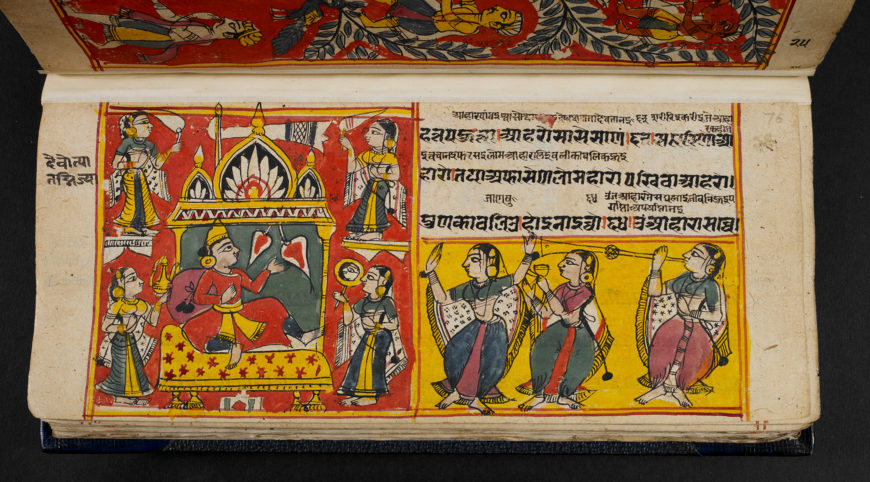
A god in his palace attended by female musicians and dancers in a manuscript of Śrīcandra’s Saṃgrahaṇīratna. (British Library)
They will have to be born as humans before they can be liberated.
In addition, there are categories of beings who are gods who do not live in the upper world: the Bhavanavāsins live in infernal dwellings located in the highest hell, the Vyantaras live just above the lower world and the gods of light, the Jyotiṣkas or the planets, illuminate the middle world.
How is the cosmology taught?
This cosmology has been passed down since the earliest scriptures, creating a scholarly tradition that has been widespread among believers in various degrees of technicity. Both Śvetāmbaras and Digambaras have described Jain geography, discussed the categories of living beings in association with forms and durations of rebirths, and written stories showing how beings travel back and forth through the three worlds. The lengthy development on cosmological matters within a compendium of doctrine such as the Tattvārthasūtra shows how crucial they are. This includes dimensions, topography, strata and dwelling places for infernal beings, descriptions of their physical features, sufferings and lifespans (chap. 3), full geography of the middle world along with classes of human beings and their lifespans (chap. 3), followed by a full exposition of the classes of deities living in the upper world and their lifespans (chap. 4).
A large number of specialised treatises on cosmology have been written by both Digambaras and Śvetāmbaras. Among the latter, two Prakrit works are widespread. The Kṣetrasamāsas (‘Condensed expositions of the areas’) lays emphasis on geographical material: the description of the continents, oceans, planets, etc. The Saṃgrahaṇīs (‘Résumés’) are more concerned with the universe in connection with karma and spiritual progress of beings. A Sanskrit manual written in verse in the 17th century, the Lokaprakāśa by Vinayavijaya, is a comprehensive treatise that includes and discusses numerous quotations from earlier works. It testifies to a period when Jains showed increased interest in this area of knowledge, perhaps as a response to new geographical and astronomical knowledge which had been brought to India by Muslims and Christians.
The study of cosmology has not focussed solely on texts. A solid tradition of visual art has developed, especially from the medieval period. The three types of texts just mentioned are those which have been most often illustrated in manuscripts. In addition, from the 18th–19th centuries onwards, another art form has developed: the making of large paintings on cloth showing the Two-and-a-Half Continents. Finally, in our times large three-dimensional models showing this region have been built and set up in important religious places (Hastinapur, Palitana) under the direction of religious teachers. The pilgrim can walk through and directly experience wandering through the world.
Although some Jain believers consider that their cosmology contains the roots of modern science and that the latter has to be ignored, the majority of them take a practical approach and accept scientific developments while continuing to study traditional cosmological theories for religious reasons.
- Nalini Balbir
- Nalini Balbir is a Professor of Indology at Sorbonne Nouvelle University Paris, where she teaches Sanskrit. She has specialised in research on various aspects of the Jain tradition. Her publications include a Catalogue of the British Library Jain manuscripts (2006, with co-authors K V Sheth, K K Sheth and C B Tripathi). She has also contributed to the JAINpedia website which includes digitised Jain manuscripts from various London collections.
Originally published on the British Library site.

